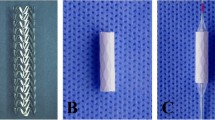Abstract
Introduction
Controversy exists as to whether Matrix coils are an improvement over bare platinum coils in preventing aneurysm recanalization in endosaccularly coiled large aneurysms. We investigated Matrix coils in a dog model of a wide-necked large bifurcation aneurysm.
Methods
Six experimental aneurysms were created in dogs and these aneurysms were endosaccularly coiled with 100% Matrix coils. Angiographic and histopathological data were analyzed at 2 weeks and at 3 months.
Results
Average aneurysm dimensions were length 17.8 mm, width 8.3 mm, and neck 6.2 mm. Aneurysm coil filling ranged 24.1–41.8% by volume. At 14 days, three of six Matrix-treated aneurysms showed coil compaction and aneurysm recanalization. At 3 months, one additional Matrix-treated aneurysm showed delayed coil compaction and aneurysm recanalization. At 3 months, in three harvested aneurysms, the average measured neck neointima was 0.150 ± 0.14 mm. However, in two of the three aneurysms harvested at 3 months, aneurysm recanalization had occurred with neointimal tissue not completely covering the aneurysm orifice. Thick connective fibrous intercoil tissue was observed. No immediate or delayed thrombus formation had occurred.
Conclusion
Based on limited data in an experimental bifurcation aneurysm in dogs, Matrix coils appear to induce a thicker aneurysm neck neointima tissue and intercoil granulation response but appear prone to coil compaction and aneurysm recanalization. Modifications to the Matrix coil are likely needed to improve angiographic results in large aneurysms.




Similar content being viewed by others
References
Molyneux A, Kerr R, Stratton I et al (2002) International Subarachnoid Aneurysm Trial (ISAT) of neurosurgical clipping versus endovascular coiling in 2143 patients with ruptured intracranial aneurysms: a randomised trial. Lancet 360:1267–1274
Molyneux A, Kerr R, Yu LM et al (2005) International Subarachnoid Aneurysm Trial (ISAT) of neurosurgical clipping versus endovascular coiling in 2143 patients with ruptured intracranial aneurysms: a randomised comparison of effects on survival, dependency, seizures, rebleeding, subgroups, and aneurysm occlusion. Lancet 366:809–817
Murayama Y, Nien YL, Duckwiler G et al (2003) Guglielmi detachable coil embolization of cerebral aneurysms: 11 years’ experience. J Neurosurg 98:959–966
Murayama Y, Vinuela F, Tateshima S, Song JK, Gonzalez NR, Wallace MP (2001) Bioabsorbable polymeric material coils for embolization of intracranial aneurysms: a preliminary experimental study. J Neurosurg 94:454–463
Lubicz B, Leclerc X, Gauvrit JY, Lejeune JP, Pruvo JP (2005) Endovascular treatment of intracranial aneurysms with Matrix coils: a preliminary study of immediate post-treatment results. AJNR Am J Neuroradiol 26:373–375
Linfante I, Akkawi N, Perlow A, Andreone V, Wakhloo A (2005) Polyglycolide/polylactide-coated platinum coils for patients with ruptured and unruptured cerebral aneurysms. A single-center experience. Stroke 36:1948–1953
Kang H, Han M, Kwon B et al (2005) Short-term outcome of intracranial aneurysms treated with polyglycolic acid/lactide copolymer-coated coils compared to historical controls treated with bare platinum coils: a single-center experience. AJNR Am J Neuroradiol 26:1921–1928
Taschner CA, Leclerc X, Rachdi H, Barros AM, Pruvo JP (2005) Matrix detachable coils for the endovascular treatment of intracranial aneurysms: analysis of early angiographic and clinical outcomes. Stroke 36:2176–2180
Niimi Y, Song J, Madrid M, Berenstein A (2006) Endosaccular treatment of intracranial aneurysms using Matrix coils. Early experience and midterm follow-up. Stroke 37:1028–1032
Fiorella D, Albuquerque FC, McDougall CG (2006) Durability of aneurysm embolization with Matrix detachable coils. Neurosurgery 58:51–59; discussion 51–59
Sluzewski M, van Rooij W (2005) Questionable interpretation of results of ACTIVE study on Matrix coils by Boston Scientific(letter). AJNR Am J Neuroradiol 26:1882–1883
Yoshino Y, Niimi Y, Song JK, Silane M, Berenstein A (2004) Endovascular treatment of intracranial aneurysms: comparative evaluation in a terminal bifurcation aneurysm model in dogs. J Neurosurg 101:996–1003
Graves VB, Strother CM, Rappe AH (1993) Treatment of experimental canine carotid aneurysms with platinum coils. AJNR Am J Neuroradiol 14:787–793
Hayakawa M, Murayama Y, Duckwiler GR, Gobin YP, Guglielmi G, Vinuela F (2000) Natural history of the neck remnant of a cerebral aneurysm treated with the Guglielmi detachable coil system. J Neurosurg 93:561–568
Tamatani S, Ito Y, Abe H, Koike T, Takeuchi S, Tanaka R (2002) Evaluation of the stability of aneurysms after embolization using detachable coils: correlation between stability of aneurysms and embolized volume of aneurysms. AJNR Am J Neuroradiol 23:762–767
Ding Y, Dai D, Lewis D, Cloft HJ, Kallmes DF (2005) Angiographic and histologic analysis of experimental aneurysms embolized with platinum coils, Matrix, and HydroCoils. AJNR Am J Neuroradiol 26:1757–1763
Szikora I, Seifert P, Hanzely Z et al (2006) Histopathologic evaluation of aneurysms treated with Guglielmi detachable coils or Matrix detachable microcoils. AJNR Am J Neuroradiol 27:283–288
Conflict of interest statement
Dr. Berenstein has consulting and/or financial interests in Boston Scientific and Microvention companies.
Author information
Authors and Affiliations
Corresponding author
Additional information
Conflict of interest statement
We declare that we have no conflict of interest.
Rights and permissions
About this article
Cite this article
Song, J.K., Niimi, Y., Yoshino, Y. et al. Assessment of Matrix coils in a canine model of a large bifurcation aneurysm. Neuroradiology 49, 231–235 (2007). https://doi.org/10.1007/s00234-006-0177-x
Received:
Accepted:
Published:
Issue Date:
DOI: https://doi.org/10.1007/s00234-006-0177-x




